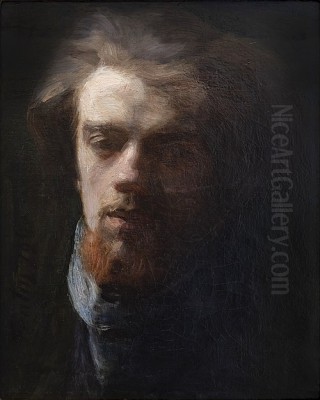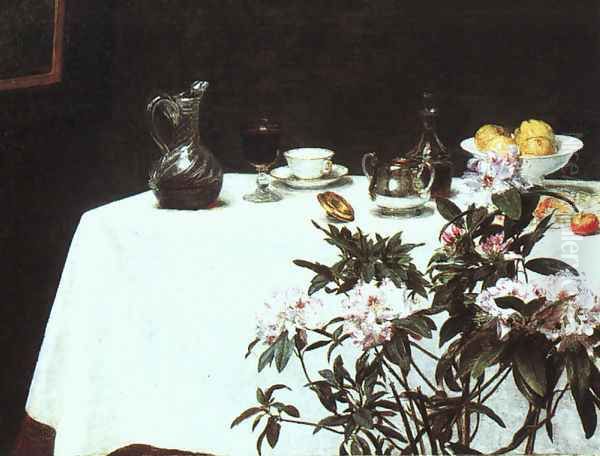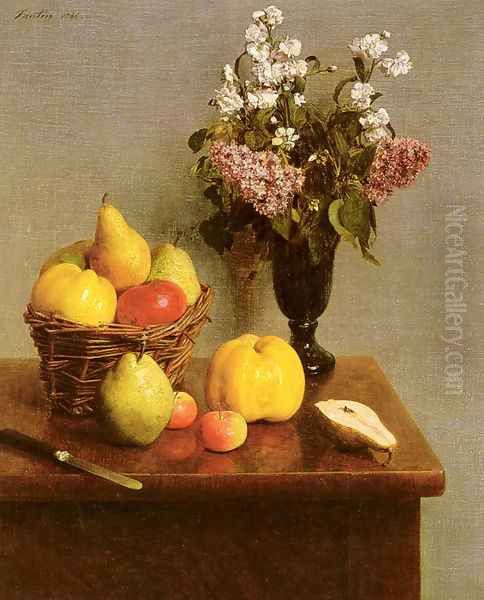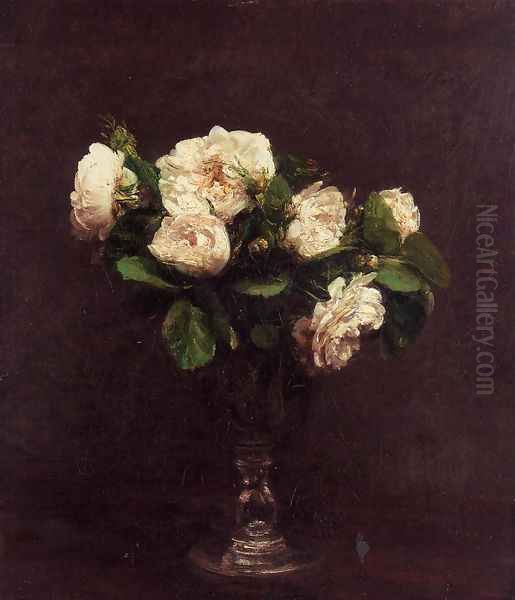
Henri Fantin-Latour stands as a significant yet often enigmatic figure in the landscape of nineteenth-century French art. Born Ignace Henri Jean Théodore Fantin-Latour on January 14, 1836, in Grenoble, and passing away on August 25, 1904, in Buré, Orne, his career spanned a period of dramatic artistic upheaval. While a contemporary and friend to many leading Impressionists, Fantin-Latour carved a distinct path, blending meticulous realism, particularly in portraiture and still life, with a deep-seated romantic sensibility evident in his imaginative compositions and lithographs inspired by music and literature. He remains celebrated for his exquisite flower paintings, insightful group portraits documenting the Parisian avant-garde, and evocative fantasy works.
Early Life and Artistic Formation
Fantin-Latour's artistic journey began under the tutelage of his father, Théodore Fantin-Latour, himself a respected portrait painter and teacher. This early grounding in traditional techniques provided a solid foundation for his future development. His mother, Hélène de Naidenoff, was of Russian aristocratic descent, adding a perhaps subtle cosmopolitan element to his background. The family moved to Paris in 1841, immersing the young Henri in the vibrant cultural heart of France.
Formal training followed, first briefly at the Petite École de Dessin under Louis-Alexandre Péron and later with Horace Lecoq de Boisbaudran, known for his memory-training methods. Fantin-Latour enrolled at the prestigious École des Beaux-Arts in 1854, though his time there was relatively short. Perhaps more influential than formal schooling was his dedicated self-education within the hallowed halls of the Louvre Museum. From around 1853 onwards, he spent countless hours meticulously copying the works of the Old Masters.
His focus was particularly drawn to the Venetian masters like Titian and Veronese, admiring their rich colour and compositional grandeur. He also studied the Dutch masters, including the profound intimacy and light effects of Johannes Vermeer and the psychological depth of Rembrandt. This rigorous practice of copying not only honed his technical skills in drawing, composition, and tonal values but also instilled in him a profound respect for tradition and a preference for studio-based work, setting him apart from the burgeoning Impressionist movement's emphasis on plein-air painting.
Navigating the Parisian Art World

Fantin-Latour entered the professional art world in the late 1850s and early 1860s, a time of intense debate and change. He made his debut at the official Paris Salon in 1861. However, like many innovative artists of his generation, he faced resistance from the conservative Salon jury. His work was rejected in subsequent years, leading him to exhibit at the landmark Salon des Refusés in 1863.
This alternative exhibition, sanctioned by Napoleon III himself, showcased works rejected by the official Salon and became a rallying point for the avant-garde. Fantin-Latour exhibited alongside Édouard Manet, James McNeill Whistler, Camille Pissarro, and others who would soon define Impressionism. While this placed him physically and socially within the circle of artistic rebellion, his own style remained distinct. He cultivated friendships with these artists but maintained a more conservative, controlled approach rooted in his Louvre studies.
His relationship with Édouard Manet was particularly significant during the 1860s. The two artists were close associates, and Fantin-Latour frequented Manet's studio, a hub for progressive artists and writers. However, Fantin-Latour never fully embraced Manet's bolder, more confrontational style, nor the Impressionists' looser brushwork and focus on fleeting light effects. He remained committed to careful modelling, precise drawing, and a more somber palette, often favouring indoor settings and controlled lighting over the Impressionist pursuit of outdoor atmosphere.
The Circle of Friends: Documenting the Avant-Garde
Fantin-Latour's most historically significant contributions are arguably his group portraits, which serve as invaluable documents of the artistic and literary circles of his time. These large-scale canvases capture the likenesses and, implicitly, the intellectual camaraderie of key figures in Parisian culture. They are rendered with a sober realism, arranged often like secular tributes or manifestos.
His first major group portrait, Homage to Delacroix (1864, Musée d'Orsay), was painted shortly after the death of the great Romantic painter Eugène Delacroix, whom Fantin-Latour deeply admired. The painting depicts a gathering of artists and writers paying tribute before a portrait of the master. Included in the solemn assembly are Fantin-Latour himself, Édouard Manet, James McNeill Whistler, the writer and art critic Charles Baudelaire, and fellow artists like Alphonse Legros and James Tissot. The composition is formal, almost photographic in its arrangement, emphasizing the shared respect for Delacroix's legacy.

Several years later, Fantin-Latour created A Studio at Batignolles (1870, Musée d'Orsay). This work centers on Édouard Manet, shown seated at his easel, surrounded by members of the group that often met at the Café Guerbois in the Batignolles district – the nucleus of what would become the Impressionist movement. Figures include painters Pierre-Auguste Renoir, Claude Monet, and Frédéric Bazille, alongside the writer Émile Zola and others. While Fantin-Latour himself stands somewhat apart compositionally, the painting captures a pivotal moment in art history, depicting the key players of the new painting just before the Franco-Prussian War and the first Impressionist exhibition.
A third major group portrait, A Corner of the Table (1872, Musée d'Orsay), shifted focus to the literary world, specifically the Parnassian poets. It depicts figures such as Paul Verlaine and Arthur Rimbaud gathered around a table at the end of a meal. Like his other group portraits, it combines meticulous individual likenesses with a sense of collective identity, rendered in his characteristic reserved and realistic style. These works cemented Fantin-Latour's reputation as a chronicler of his time, capturing the faces of modern creativity.
Mastery of Still Life: The Flower Paintings
While his group portraits brought him critical attention, it was Fantin-Latour's still life paintings, particularly his depictions of flowers, that secured his financial success and widespread popularity, especially in England. Throughout his career, he produced hundreds of flower paintings, ranging from simple arrangements to elaborate bouquets, demonstrating an extraordinary sensitivity to the texture, colour, and delicate forms of blooms.
His approach to flower painting was distinct from the more decorative traditions. He rendered roses, peonies, chrysanthemums, and other flowers with botanical accuracy yet imbued them with a quiet poetry. His technique involved careful drawing, subtle tonal gradations, and often a relatively thin application of paint, allowing the textures of petals and leaves to emerge softly against typically neutral, atmospheric backgrounds. He masterfully captured the play of light on surfaces, conveying both the fragility and the vibrancy of his subjects.
Fantin-Latour found a receptive market for these works in England, facilitated initially by his friendship with James McNeill Whistler and later through connections with collectors and dealers like Edwin and Ruth Edwards. The English taste for detailed realism and intimate subject matter aligned perfectly with Fantin-Latour's floral compositions. This steady income stream provided him with financial stability, allowing him the freedom to pursue his more ambitious, less commercially viable figure paintings and imaginative works. His wife, Victoria Dubourg, whom he married in 1876, was also a talented still life painter, and they likely influenced each other's work in this genre. His dedication elevated flower painting beyond mere decoration, echoing the profound simplicity found in the works of earlier masters like Jean-Baptiste-Siméon Chardin.
Individual Portraits and Intimate Scenes

Beyond the large group compositions, Fantin-Latour was also a skilled painter of individual portraits. These works often display the same psychological acuity and realistic precision seen in his group scenes. He painted portraits of friends, family members, and fellow artists, including sensitive likenesses of Manet and Whistler. These portraits are typically characterized by their restrained palettes, solid forms, and focus on capturing the sitter's personality and presence through subtle expression and pose.
An early example showcasing his interest in intimate, personal subjects is The Two Sisters (1859, Saint Louis Art Museum). This painting depicts his own sisters, Nathalie and Marie, engaged in quiet domestic activities – one reading, the other sewing. The work demonstrates his ability to handle complex interior light and imbue a simple scene with a sense of contemplative stillness and familial connection. It reflects the influence of Dutch genre painting while maintaining his own distinct, slightly melancholic realism.
These individual portraits and intimate scenes further highlight Fantin-Latour's commitment to observation and his ability to convey character without resorting to overt drama or elaborate settings. They stand as quieter counterpoints to his grander group portraits and his more fantastical explorations of music and myth.
The Realm of Imagination: Music and Lithography
Parallel to his realistic portraits and still lifes, Fantin-Latour nurtured a deep passion for music and literature, which fueled a significant body of imaginative work, particularly in the medium of lithography. He was an ardent admirer of Romantic composers, especially Richard Wagner, Hector Berlioz, Robert Schumann, and Johannes Brahms. Their music evoked powerful visual imagery in his mind, which he sought to translate into art.
Starting in the 1860s and continuing throughout his life, Fantin-Latour produced numerous lithographs inspired by scenes from Wagner's operas (such as Tannhäuser, Lohengrin, and the Ring Cycle), Berlioz's dramatic symphonies, and Schumann's compositions. These prints often feature swirling, dreamlike compositions, mythological figures, and dramatic landscapes, rendered in rich blacks and subtle grays. They stand in stark contrast to the sober realism of his portraits, revealing a more overtly Romantic and Symbolist leaning.

He also created paintings based on mythological or allegorical themes, such as The Temptation of Saint Anthony and various depictions of nymphs, bathers, and scenes inspired by classical mythology. These works allowed him to explore themes of fantasy, sensuality, and the sublime, moving away from direct observation towards the evocation of mood and idea. This aspect of his oeuvre connects him to the Symbolist movement, which gained traction in the later nineteenth century, sharing interests with artists like Odilon Redon who also explored dreamlike and suggestive imagery, often through printmaking. Fantin-Latour's dedication to lithography was significant; he embraced the medium's potential for tonal richness and expressive freedom, becoming one of its most accomplished practitioners in the nineteenth century.
Style and Technique: A Bridge Between Worlds
Henri Fantin-Latour's artistic style is characterized by its unique position between the established traditions of Realism and Romanticism and the emerging currents of Impressionism and Symbolism. He was fundamentally a studio painter, relying on careful preparation, precise drawing, and controlled execution. His commitment to realism is evident in the accurate likenesses of his portraits and the detailed rendering of his still lifes. He possessed a masterful command of tonal values, creating subtle transitions of light and shadow that give his subjects solidity and presence.
His technique often involved building up layers of paint, sometimes using glazes or thin washes (scumbles) to achieve nuanced effects, particularly in his flower paintings and the atmospheric backgrounds of his portraits. This contrasts sharply with the Impressionist technique of using broken color, visible brushstrokes, and painting outdoors (en plein air) to capture fleeting moments of light and atmosphere, as practiced by artists like Monet, Renoir, and Pissarro.
While grounded in realism, Fantin-Latour's work is also deeply infused with a Romantic sensibility. This is most apparent in his imaginative lithographs and paintings inspired by music and myth, but it also subtly informs his portraits and still lifes through their often melancholic or contemplative mood. He sought not just to record appearance but also to evoke feeling and psychological depth. His connection to Symbolism lies in this emphasis on suggestion, mood, and the exploration of inner worlds, particularly in his later graphic work. He shared with artists like Edgar Degas a connection to the Impressionist circle but maintained a strong individual style rooted in drawing and studio practice.
Later Life and Legacy
In 1876, Fantin-Latour married fellow painter Victoria Dubourg. The marriage appears to have been a happy and supportive one. The couple spent their summers at Victoria's family estate in Buré, a village in Lower Normandy. This rural retreat provided a peaceful contrast to the bustle of Paris and likely offered ample inspiration for their respective still life paintings. Fantin-Latour continued to work prolifically throughout his later years, increasingly focusing on lithography alongside his painting.

He continued to exhibit regularly, though he largely remained aloof from the factionalism of the Parisian art world. His reputation, particularly for his flower paintings and portraits, remained solid, especially in England and America. He received official recognition in France, being made a Chevalier of the Legion of Honour in 1879.
Henri Fantin-Latour died on August 25, 1904, while staying in Buré. He was buried in the Montparnasse Cemetery in Paris, a resting place for many prominent artists and intellectuals. His legacy is that of a highly skilled and sensitive artist who navigated a complex period in art history with integrity and a unique vision. He was a master technician, a perceptive portraitist, a celebrated painter of flowers, and an imaginative interpreter of music and myth.
His influence can be seen in the continuation of realist traditions in portraiture and still life, and his group portraits remain essential documents for understanding the cultural life of nineteenth-century Paris. While perhaps not as revolutionary as his Impressionist friends, Fantin-Latour occupies a crucial and respected place, acting as a bridge between the academic tradition, the realism of Gustave Courbet, the innovations of Manet, and the introspective explorations of Symbolism.
Conclusion
Henri Fantin-Latour remains a compelling figure in French art history. His dedication to craft, learned through diligent study of the Old Masters, provided the foundation for a body of work characterized by technical excellence and subtle observation. His group portraits immortalized the faces of the Parisian avant-garde, while his exquisite flower paintings achieved international renown and secured his livelihood. Simultaneously, his imaginative lithographs and paintings revealed a deep engagement with the Romantic worlds of music and literature, aligning him with the burgeoning Symbolist movement. Though closely associated with the Impressionists, he maintained his artistic independence, creating a unique synthesis of realism and romanticism. Fantin-Latour's art offers a quiet but profound reflection on the people, objects, and imaginative realms that captured his attention during a transformative era.